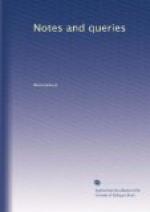MARK ANTONY LOWER.
Lewes.
Cockade and True Blue (Vol. iii., pp. 7. 27.) both owe their origin to the wars of the Scottish Covenanters; and the cockade appears to have been first adopted as a distinguishing emblem by the English army at the battle of Sherra-muir, where the Scotch wore the blue ribbon as a scarf, or on their bonnets (which was their favourite colour). The English army then, to distinguish themselves, assumed a black rosette on their hats; which, from its position, the Scotch nick-named a “cock’ade” (with which our use of the word “cockscomb” is connected) and is still retained.
An old Scotch song describing, “the Battle of Sherra-muir” (which name it bears) in verse 2., line 1., speaks of the English as—
“The red-coat lads, wi’ black cockades;”
verse 3., describing the Scotch and their mode of fighting, says,—
“But had you seen the philibegs,
And skyrin tartan trews, man,
When in the teeth they dared our Whigs,
And Covenant TRUE-BLUES, man;
In lines extended lang and large,
When bayonets opposed the targe,
And thousands hasten’d to the charge,
Wi’ Highland wrath, they frae the
sheath
Drew blades o’ death, till, out
o’ breath,
They fled like frighted doos,
man.”
The song, which is rather a long one, carries you with the army to the Forth, Dumblane, Stirling, Perth, and Dundee. Oft referring to the “Poor red-coat,” and to the “Angus lads.”
BLOWER.
The Vavasours of Hazlewood (Vol. ii., p. 326.).—1. It is a well-known fact that the stone for York minster was given by the Vavasour family. To commemorate this, there is, under the west window in that cathedral, a statue of the owner of Hazelwood at that period, holding a piece of stone in his hand. Hence may have arisen the tradition that the chief of the family might ride into York minster on horseback.
{72} 2. In feudal times Hazlewood was a fortified castle, having its regular retainers, &c.
3. Hazlewood Chapel was the only Roman Catholic parish church in England which did not become a Protestant church at the Reformation.
CHAS. D. MARKHAM.
Jan. 10. 1851.
"Breeches” Bible (Vol. iii., p. 17.).—In quoting from specimens of early printing, correctness of orthography, even in trivial matters, is desirable, and therefore I venture, in allusion to the interesting communication from [Curly-pi] on the subject of the Geneva or “Breeches” Bible, to state that the edition of 1576, in my possession, is “Imprinted by Christopher Barkar” (not Barker), “dwelling in Paternoster Rowe, at the signe of the Tygres Head.”
The text quoted varies also in two or three words from my copy, and it is probably from the Geneva edition. The English edition of 1576 runs thus, (Gen. iii. 7.): “Then the eyes of them both were opened, and they knew that they were naked, and they sewed figge tree leaves together, and made them selves breeches.” I am, sir, yours truly,




